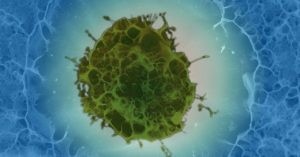A new prime and boost cell therapy for treating cancer?
The cell therapy space has been pretty fast moving since Penn announced they had successfully treated two children with a form of acute leukemia using a CAR-T cell therapy to hunt down and kill all of the tumour cells that express CD19 in 2012. This approach has since gone on to be studied in several tumour types by many companies with both self (autologous) and donor (allogeneic) products, leading to the first two FDA approvals in leukemia and lymphoma.
 At the other end of the spectrum was the antibody companies, who initially saw checkpoint antibodies as a way of doing a similar thing (killing cancer cells) with a different form of immunotherapy more suited to solid tumours. A raft of approvals followed in a variety of tumour types across multiple companies.
At the other end of the spectrum was the antibody companies, who initially saw checkpoint antibodies as a way of doing a similar thing (killing cancer cells) with a different form of immunotherapy more suited to solid tumours. A raft of approvals followed in a variety of tumour types across multiple companies.
Thing is, neither approach is ideal as a standalone since they both have limitations, albeit different ones…
There is no doubt that CAR-T cell therapy has been associated with grade 3/4 events relating to severe cytokine syndrome (CRS) and neurotoxicity, while checkpoint blockade is no walk in the park — especially in combination — with severe immune related toxicities being reported including hepatitis, pneumonitis, colitis and such-like.
Then there’s relapse and immune escape to consider, not to mention lack of T cells in colder tumours (low pre-existing immunity) and the hostile tumour microenvironment that can exert multiple inhibitory actions, all of which can contribute to a dampening effect on people’s ability to mount a sustained and durable immune response against the cancer.
What if there was a different way?
We’ve heard from several KOLs who have been in the BSB hotseat over the last year that pre-existing immunity (high presence of CD8+ T cells in the tumour) can drive the initial immune response and that defects in the antigen presentation (APC) machinery can limit efficacy.
These twin issues can potentially be addressed in a number of ways. I was particularly intrigued by some novel preclinical ideas and approaches teach us how primed and expanded effector CD8+ T cells can be generated in large numbers… the good news is that there are plenty of useful applications for this creative technology, so what’s behind the science?
To learn more from our latest assessment and get a heads up on our oncology insights, subscribers can log-in or you can click to gain access to BSB Premium Content.
This content is restricted to subscribers
Background
A brief back story by way of introducing today’s topic… a while back I remember reading and bookmarking this nicely written Xconomy article on a start-up called SQZ biotech who had developed a process called Cell Squeeze to go with my small collection of notes on the electroporation of cells, a prcoess that biologists have often used as a way to open up cell membranes briefly.
Fast forward a year later, when someone interested in CAR T cell therapies sent me a published paper, asking me what I thought of the concepts described within and whether they might possibly apply to CAR T cells?
The main issue I saw back then was (according to my scribbled notes from 2015) was that with CD19 directed CARs and BiTEs, they basically wipe out all the B cells thereby making it difficult to see how you could viably use them in that particular context, as this quote from Szeto et al., (2015) shows:
“B-cells are promising candidate autologous antigen-presenting cells (APCs) to prime antigen-specific T-cells both in vitro and in vivo. However to date, a significant barrier to utilizing B-cells as APCs is their low capacity for non-specific antigen uptake compared to ‘professional’ APCs such as dendritic cells.”
If you put in a batch of ex vivo loaded B cells that still have CD19 antigen on their surface, they would likely be lost and gobbled up by the trained killer CAR cells. You see the same thing with the Mayo measles virus where residual memory cells in previously vaccinated myeloma patients wiped out the oncolytic virus before they could destroy the myeloma cells. This sort of scenario would be akin to those Pacman games, where the ghouls often attack in numbers and destroy the Pacman first.
The Nature paper, by the way, is well worth reading for those of you interested in cancer vaccines that are based on dendritic cells, which have the advantage of efficiently priming of T cells, but also face many disadvantages, as we have seen with decades of research trying to get them (mostly unsuccessfully) to scale as effective anti-cancer therapies:
“DCs are limited by their relative paucity in human blood, complex subset heterogeneity, short lifespan, and inability to proliferate.”
In the 2014 Xconomy piece, they show the researchers original hand drawn cartoon explaining how ‘stuff’ (lovely technical term for DNA/RNA/antibodies etc) could be essentially pushed into cells using a microchip made of silicon and glass that literally puts a little bit of squeeze on them – enough to open the membranes so that proteins can enter without nihilistically killing them in the process.
Monoclonal and bispecific antibodies, as many of you know, can be pretty large molecules at least compared to the molecular weight of TKIs, so they can be unwieldy in the blood stream at times. Would this squeezing approach help get more drug into tumours and also improve the priming process by increasing the number of CD8+ T cells, thereby improving anti-cancer immunity?
While the squeeze concept may not have much application to CAR T cell immunotherapies per se – other than as a major competitor if the concept works well in humans with fewer severe side effects – given the rise in immunotherapies using checkpoint and bispecific antibodies in solid tumours, there could be many potentially useful combination applications that could be explored here.
Little did I know then that one of the co-authors of that Nature paper would end up as CEO of a biotech exploiting the technology behind the ideas and I’d be interviewing them about new developments about their fascinating work!
Interview with Dr Armon Sharei, CEO of SQZ Biotechnologies
BSB: How do we go from “squeezing” antigen presenting cells (APCs) to improving the performance of the APCs?

Dr Armon Sharei, SQZbio
Dr Sharei: How does squeezing APCs improve their performance? If you think about the mechanisms of antigen presentation, by their nature APCs are going to be taking material from their cytosol, chopping it up and presenting it on their surface and MHC class I.
When it comes to normal antigen presentation happening in the body, like let’s say when you have an infection or something your APCs are going to eat up infected cells, and those materials will end up in the endosomes, which means from an antigen presentation perspective, a lot of it will go to MHC class II, and only a fraction of it will go to MHC class I.
MHC class II is generally going to drive CD4 responses, whereas class I is what drives CD8 responses, which in the context of cancer is really, really what you want to focus on because the CD8 T cells are the killer T cells.
Where normally your APCs are relatively inefficient on how much they’ll present on MHC class I, with using squeeze because we can deliver these antigens directly into the cytosol, you’re going to have these antigens in the cytosol where they’re a lot more accessible to the class I presentation pathway, unlike the endosomes, and so that probably get much better presentation of antigen and can therefore drive stronger CD8 responses.
BSB: If you think about the checkpoint therapies out there, patients relapse because of acquired resistance and maybe in some cases they have loss of MHC class I, with your approach would you restore that or is it something that would delay the onset of that loss?
Dr Sharei: The MHC class I loss in the tumour is a slightly different kind of animal as far as how that occurs, really what we’re trying to do is induce more and more powerful T cell responses against the tumour targets in the first place.
Once you have these greater T cell responses, when they enter a tumour microenvironment that you’ve hopefully been combating with a checkpoint inhibitor, they can drive a much more inflammatory effect.
That in of itself should give you much better killing, and the inflammatory environment that you create with this influx of CD8 T cells will actually overcome a lot of the down-regulation of class I because you’re going to have for example, interferon signalling which will up-regulate class I back up, so unless these tumours have completely deleted MHC class I, which is not common, you can probably recover that class I expression and have these CD8 T cells kill those tumour cells.
This inflammatory environment would also drive influx of NK cells, for example, which will just inherently kill based on the absence of class I, if these cells have down-regulated or deleted it.
BSB: Where there are cases when they have problems in the antigen presentation machinery, you may still have MHC class I present, but maybe not in an optimal fashion, so the approach that you have could potentially improve that?
Dr Sharei: If you think about most tumours, you really are fighting an uphill battle with the endogenous antigen presentation pathways, because these APCs are going to pick up antigens in an immuno-suppressive environment which is the tumour or draining lymph node, and so not only do they have to contend with the inefficiencies of endocytosis, but also deal with that tolerogenic environment, which can make it much harder for that endogenous machinery to prime a good CD8 response, so by short cutting that whole process, you should be able to drive a much more effective CD8 response that can then go and destroy the tumour.
BSB: Is this something that you could also potentially use with adoptive cell therapies such as CAR T cell therapies for example?
Dr Sharei: Mechanistically I don’t necessarily think you would combine this with CARs because for the types of tumours we’d be going after, like the solid tumours with HPV+ cancers, those aren’t areas where CARs are, today at least, work.
And the mechanism by which the CARs work relies on antibody-mediated targeting of certain surface antigens, which are different from the kinds of antigens that a CD8 T cell would see through a TCR, so I don’t think it’s likely you could do that.
BSB: Potentially it might be technically feasible though, if they crack a lot of the issues they’ve been seeing with solid tumours?
Dr Sharei: Yeah, I think if they can find good solid tumour targets for CARs, it could potentially become something that’s complementary down the line, but I don’t know if they are far enough in showing that yet.
BSB: In terms of the checkpoint therapies, we see some relatively low response rates say 10–20% of patients in numerous tumours, outside of melanoma, so is your approach a stand alone product you could give or is it something that could be built into a checkpoint molecule?
Dr Sharei: So we’re actually looking at both strategies, both as a monotherapy and as a combination.
Mechanistically, the way we’ve been aiming to have this work, and the way we believe it should work based on the preclinical data we see, is that you would use this to create a more powerful CD8 response against a particular target of interest.
That’s solving a pretty significant portion of the immunological problem of how do you attack a tumour, but once you have these CD8 responses and they enter the tumour microenvironment (TME), they would still benefit probably from having a checkpoint inhibitor present, to allow them to have significant function while they’re in there, so ultimately you are ideally combining the two.
Based on what we see preclinically, we could probably have a strong effect as a monotherapy as well.
BSB: In terms of the starting point of where you might go with solid tumours, is this something that you’re seeing as being useful for high immunogenic tumours like melanoma, lung and bladder or is this something where you see potential in colder tumours that don’t have very much checkpoint activity for various reasons?
Dr Sharei: We’re actually thinking about both of those categories, but with a slightly different lens as to how we would divide them up.
In our case, we think of those broader set of tumours in the context of either there is a good defined antigen to go after, or one would have to take more of a lysate phased approach.
So what I mean by that, is let’s say in these head and neck and cervical cancers we’re after for HPV+ tumours, E6 and E7 are two known viral drivers that have been inserted into these cells, and so they seem to be driving this effect. If you can raise a strong CD8 response against those drivers, you should, in principal be able to vanquish the tumour because you’re targeting something that it can’t evolve away from.
Whereas if you were going after a antigen that wasn’t critical to the tumour’s function or survival, it could probably evolve away from it and even if you induced a strong immune response, you may not be able to get rid of it.
Now in some tumour types, it’s less clear or it’s too patient specific to back out what a common driver antigen would be, and so like in melanoma for example, it doesn’t necessarily have a common driver, subsets of them might, but overall they don’t necessarily have that, and in those cases the approach that we would be looking to implement is to actually is to take a biopsy of the tumour, lyse it and deliver that whole mix of proteins into the APCs, and just let the APCs process and present everything, and your body would preferentially induce an immune response against anything that’s a novel antigen, as opposed to anything that’s self.
In that way, you can go after both tumours where you don’t know that much about what’s driving them or what would be a good target specially, and go after tumours where you do know enough about that.
It’s a bit of a different categorization from the “hot” and “cold” aspects, but it’s something that overall would still allow you to go after all these different tumour types. The hot and cold might be a layer on top of that, where in that context you might think about more less about how much of a checkpoint inhibitor kick you need.
Something that’s a relatively cold tumour, may benefit a lot from just the monotherapy of this, because you’re going to drive more CD8s into that environment, whereas something that’s a relatively hot tumour might benefit more the presence of a checkpoint because you already have a good amount of T cells in there.
BSB: Can you regulate how much impact these APCs will have, almost like a rheostat, so you could have a low amount for those where there’s some activity and maybe more for the cold tumours?
Dr Sharei: We haven’t thought in depth about whether or not we would try to implement something like that.
The short answer is ‘yes’ – we can modulate it by dosing. How many APCs you give is correlated with how much of a CD8 response you’ll create, within a certain range.
You could in principal do that, but I think mechanistically what we’ve been seeing preclinically, which gives us some encouragement for the clinical context, is that at least preclinically, we don’t seem to have significant side effects from doing this.
You might find yourself in a situation where you’re potentially pretty safe with doing this, and so there isn’t much of a problem if you dial up the CD8 response, even if you didn’t necessarily need to go that high, because it’s not like you’re doing it at the cost of a certain toxicity, necessarily.
Obviously, we won’t know that for sure until we go into humans, but at least preclinically that seems to be the case.
BSB: You mentioned earlier about being able to squeeze the APCs into the tumour microenvironment, would they be able to cross the blood-brain barrier by being squeezed through?
Dr Sharei: The APCs themselves, I don’t know if they would, but the CD8 responses they induce, those T cells might be able to get into those tissues as well.
BSB: Thank you very much for your time.
Additional Commentary
This week, SQZ Biotechnologies and Roche announced that they were extending their ongoing collaboration, which makes intuitive sense given the ongoing relationship. I think it will be really interesting to see what they with the technology. If we think about this deal and go back to the earlier point about creating super B cells, then you can see with Roche/Genentech’s long term interest in B cell biology, under the collaboration they could potentially create a new type of cell therapy that is not based on TILs, vaccines, or CAR-T cells.
How would that potentially work in practice though? Basically, in layman terms you could take selected antigens from a patient’s tumour, insert (squeeze) them into apheresed B cells ex vivo, then give the loaded B cells back to the patient. Thus the idea here would be that the primed B cells could potentially train the body’s T cells to hunt down the cancer cells.
Now we still need to get the T cells inside the tumour in order to modulate the tumour microenvironment… In the Nature paper mentioned above, the researchers also noted that:
“Squeezed B-cells primed and expanded large numbers of effector CD8+ T-cells in vitro that produced effector cytokines critical to cytolytic function, including granzyme B and interferon-γ.”
Which is great, except that I can almost hear a few readers exclaim that it’s all very well increasing the number of CD8+ T cells in a test tube or culture, but what if they still get stuck in the tumour margins of patients and don’t (or can’t) penetrate the cold tumour microenvironment? That’s certainly a risk and we’ll have to see what actually happens in the clinic. We certainly shouldn’t over-simplify here and forget how complex the immune system is or underestimate how devious cancer is in evading whatever is through at it.
Note that this super B cell concept is the opposite of what CD19 CAR-T cell therapy does since there, all the B cells are wiped out nihilistically (due to the presence of the CD19 target), whereas here you’re adding super B cells back in as a kind of primed trojan horse that can boost the number of cytolytic CD8 T cells that then hunt down the cancer cells and kill them.
It’s a bit like modern Generals (APCs and supercharged B cells) telling the army of killer T cells what to do, only with more detailed or precise instructions than they would in the past because they’ve been primed with relevant information. It’s a neat concept that has many possibilities as they head into the clinic next year. The real proof though, is not in hypotheses and preclinical data but what happens in humans with disease. It could be well worth watching out for because traditional methods aren’t proving to work as well as hoped for – Roche just abandoned a bunch of early pipeline compounds such as their anti-CSF-1R molecule and need to move newer and more potent ideas along to the clinic. Not everything works, that’s accepted practice, but smart companies ditch dogs early and continue experimenting with other ideas.
There are a number of different ‘prime and boost’ approaches out there, including dendritic and neoantigen vaccines, but this concept while early is rather promising.
There are other applications if we think about the perennial problem of trying to box in immune escape mechanisms and achieving an effective therapeutic index. In a recent paper, they describe the results of a preclinical experiment with the JAK pathway, which is often upregulated in cancer and a known cause of resistance:
“The Cell Squeeze platform increases permeability regardless of compound structure by mechanically disrupting the membrane, which can overcome permeability limitations and bridge the gap between biochemical and cellular studies. In this study, we show that poorly permeable Janus kinase (JAK) inhibitors are delivered into primary cells using Cell Squeeze, inhibiting up to 90% of the JAK pathway, while incubation of JAK inhibitors with or without electroporation had no significant effect.”
In the meantime, the SQZbio researchers have another paper in press (expected next month), where they show their microfluidic process is superior to electroporation. We’ll add some additional notes here once the article is available.
PS it was very tempting to engineer a whole lexicon around squeeze play terminology, but strategically I was thinking more of defense can the best form of attack and how NFL coaches use complex blitz plays to confuse a QB and tricking him into making unforced errors. Perhaps using super B cells to prime and boost the killer T cells will sucker the cancer cells into not seeing the cell equivalent of a MLB such as Lawrence Taylor lurking behind and… Bam!
This content is restricted to subscribers

